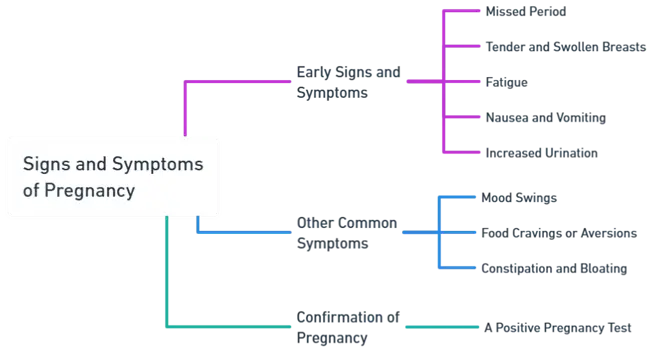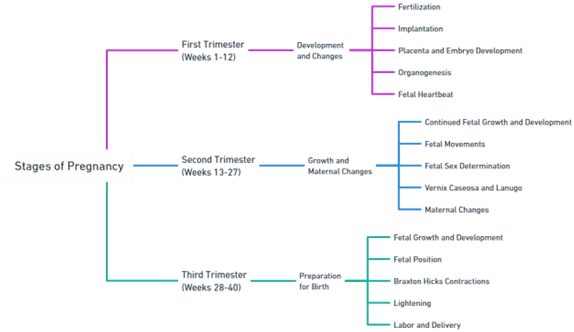- Pregnancy is the period during which a fertilized egg (zygote) develops into a fetus inside the uterus of a female.
- It usually lasts around 40 weeks, or about 9 months, from the first day of the last menstrual period (LMP) and is divided into three trimesters.
Signs and symptoms of pregnancy

This is a sample ad placement!
Early Signs and Symptoms
- Missed Period: Often the first and most noticeable sign of pregnancy, especially if you have a regular menstrual cycle.
- Tender and Swollen Breasts: Hormonal changes in early pregnancy can make breasts feel sore, sensitive, or heavier than normal.
- Fatigue: The rise in progesterone levels can lead to feelings of tiredness and exhaustion, even in the early stages of pregnancy.
- Nausea and Vomiting: Widely known as “morning sickness,” this symptom can occur at any time of the day and is most common during the first trimester, though it can extend beyond for some women.
- Increased Urination: The need to urinate more frequently is prompted by hormonal changes and an increase in blood volume.
Other Common Symptoms
- Mood Swings: Emotional fluctuations are common, caused by changes in hormone levels.
- Food Cravings or Aversions: It’s not unusual for pregnant women to have a strong desire for certain foods or an aversion to others, a phenomenon driven by hormonal variations.
- Constipation and Bloating: Slower digestive processes, due to hormonal effects, can lead to constipation and a bloated feeling.
This is a sample ad placement!
Confirmation of Pregnancy
- A Positive Pregnancy Test: The most definitive early sign of pregnancy is a positive result on a pregnancy test, which detects the presence of the hormone human chorionic gonadotropin (hCG).
Stages of pregnancy

This is a sample ad placement!
First Trimester (Weeks 1-12)
Development and Changes:
-
Fertilization:
- The journey begins when a sperm fertilizes an egg, forming a zygote, marking the conception and start of pregnancy.
-
Implantation:
- The zygote divides multiple times, becoming a blastocyst that implants into the uterine lining about 6-10 days after fertilization, establishing the foundation for embryo development.
-
Placenta and Embryo Development:
- The blastocyst differentiates into the embryo and placenta. The placenta acts as a life-support system, delivering nutrients and oxygen to the developing fetus.
-
Organogenesis:
- This is a critical phase where the embryo’s organs start forming. Notable developments include the neural tube (which becomes the brain and spinal cord), the heart, and limb buds.
-
Fetal Heartbeat:
- By around 6-8 weeks, the fetal heartbeat can be detected via ultrasound, marking a significant milestone in development.
Second Trimester (Weeks 13-27)
Growth and Maternal Changes:
This is a sample ad placement!
-
Continued Fetal Growth and Development:
- The fetus undergoes rapid growth, and features like facial features, fingers, and toes become more defined.
-
Fetal Movements:
- Between 16-20 weeks, the mother may feel the foetus’s movements, known as quickening, a sign of active fetal development.
-
Fetal Sex Determination:
- Around 18-22 weeks, the foetus’s genitalia can be distinguished via ultrasound, allowing parents to know the baby’s sex.
-
Vernix Caseosa and Lanugo:
- The fetus develops a protective, waxy coating called vernix caseosa and fine hair called lanugo, which help regulate body temperature and protect the skin.
-
Maternal Changes:
- As the fetus grows, the mother’s uterus expands, leading to physical symptoms like backaches, leg cramps, and heartburn.
Third Trimester (Weeks 28-40)
Preparation for Birth:
-
Fetal Growth and Development:
- The fetus continues gaining weight and further develops organ systems, preparing for life outside the womb.
-
Fetal Position:
- Most fetuses move into a head-down position, optimal for birth.
-
Braxton Hicks Contractions:
- These are irregular, non-painful contractions as the body prepares for labor.
-
Lightening:
- The fetus “drops” lower into the pelvis, relieving pressure on the mother’s diaphragm and making breathing easier.
-
Labor and Delivery:
- The final stage of pregnancy culminates in labor and delivery, where contractions become regular and more intense, leading to the birth of the baby.
This is a sample ad placement!
Thank you for reading from Firsthope's notes, don't forget to check YouTube videos!
